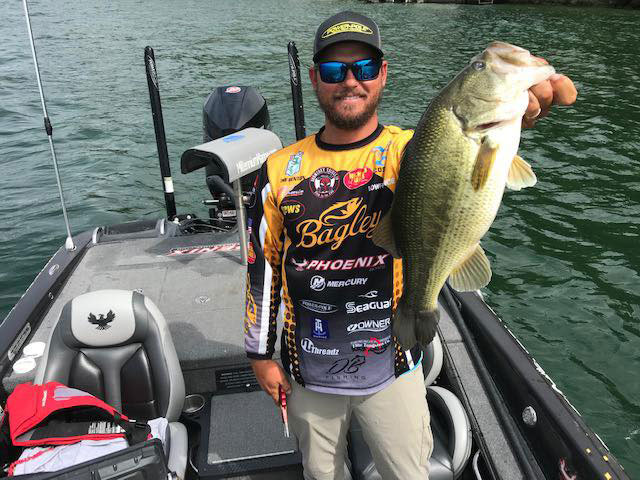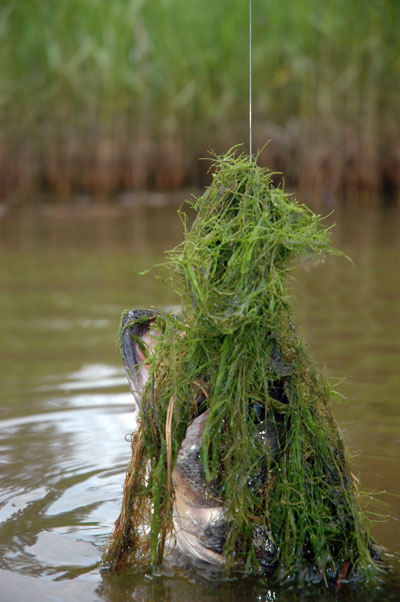Using Electronics, Worms and Crankbaits
provided by John E. Phillips
Thirty-two-year-old Drew Benton from Panama City, Florida, has been tournament fishing for 16 years. He began his tournament fishing career on the FLW Circuit and fished three seasons there, then moved to the Bassmaster Elite Series in 2016 and has qualified for the Bassmaster Classic for 3 years. Drew Benton finished third in the Bassmaster Elite Series Lake Eufaula tournament with 88 anglers on June 13, 2020, catching a total of 82 pounds, 4 ounces of bass to win $20,000.

When I move out to deep water in hot weather I really depend on my depth finders. I use a Lowrance HDS 12. I like this unit because I can see everything under the water that I want without straining my eyes. One of the features that I like the best is the StructureScan transducer that enables me to see what type of grass is under the water. I also can spot the bait fish on which the bass are feeding. Because of my depth finder, I’ll have a super-clear image of everything around the boat. I even can tell the kind of grass, whether it’s hydrilla, milfoil or eel grass. When we’re fishing in the North, I can tell the difference in the water-lettuce type grass there too. On Lake St. Clair (in Michigan), I can see what looks like a moss kind of grass growing on the bottom. Usually, I’m running two units on my console and two on my casting deck. Then I can keep side imaging and down imaging on one unit and have my mapping and sonar on the other unit at the console. On my casting deck, I’ll have the Lowrance LiveSight and my mapping and 2D sonar on the other unit.
Whenever I’m on the casting deck fishing, I’ll know where the patch of grass that I want to fish is. If I’m fishing grass on a break line, I can see what’s on that break line as I fish it. Another thing I like about this unit is that it has range lines that tell me how far I have to cast to hit the target I’m trying to reach. If there’s some separation between the bass and the grass, I can spot the bass, but if the bass are down in the grass, I can’t see them. However, I can see schools of shad, and how the bait is relating to those schools of shad when I’m fishing out in deep water.
Plastic Worms
 My bait of choice to fish for deep-water bass is a big plastic worm, since the bass in hot weather aren’t really willing to chase a lure to eat it. I can drag a big plastic worm that I’ve rigged Texas style slowly across the bottom and/or above the grass. I prefer a 10-inch Big Bite Bait B2 worm - a ribbon tail worm. The clearer the water, the more natural worm I prefer to fish. My three favorite colors of the B2 worm are green-pumpkin magic, plum and junebug. When fishing the B2 worm, I increase the size of my hook to a No. 5/0 wide gap Owner worm hook. I’ll be fishing Seagaur Invizx 20-pound-test fluorocarbon line, and the weight I usually put in front of the worm will be a 3/8-ounce bullet weight to fish water that’s less than 12-feet deep. If I’m fishing 12-foot deep or more, I may use a 1/2-ounce bullet weight. When I’m fishing a worm in deep water, I like a 7-foot, 7-inch heavy-action MBX Phenix rod with an 8.3:1 gear ratio reel. I like this high-speed reel because oftentimes when a bass picks up my worm, it will be moving. So, I want a reel that can pick up line fast. Once I set the hook, I’ll try to get the bass to the boat quickly.
My bait of choice to fish for deep-water bass is a big plastic worm, since the bass in hot weather aren’t really willing to chase a lure to eat it. I can drag a big plastic worm that I’ve rigged Texas style slowly across the bottom and/or above the grass. I prefer a 10-inch Big Bite Bait B2 worm - a ribbon tail worm. The clearer the water, the more natural worm I prefer to fish. My three favorite colors of the B2 worm are green-pumpkin magic, plum and junebug. When fishing the B2 worm, I increase the size of my hook to a No. 5/0 wide gap Owner worm hook. I’ll be fishing Seagaur Invizx 20-pound-test fluorocarbon line, and the weight I usually put in front of the worm will be a 3/8-ounce bullet weight to fish water that’s less than 12-feet deep. If I’m fishing 12-foot deep or more, I may use a 1/2-ounce bullet weight. When I’m fishing a worm in deep water, I like a 7-foot, 7-inch heavy-action MBX Phenix rod with an 8.3:1 gear ratio reel. I like this high-speed reel because oftentimes when a bass picks up my worm, it will be moving. So, I want a reel that can pick up line fast. Once I set the hook, I’ll try to get the bass to the boat quickly.
Crankbaits in Deep-Water Grass
I’ll also fish a crankbait when I’m fishing grass in deep water to try to get a reaction strike from the bass. I want my crankbait to get its treble hooks down and be able to just touch the top of the grass. So, I’m looking for a crankbait that’ll get down to the grass I want it to tick, and I want that crankbait to have a bill that won’t pick up a lot of grass and cause the crankbait not to wobble but come through grass really well. I’ll use my LiveSight on my depth finder to find big clumps of grass on the bottom. Next, I’ll cast my crankbait to that big underwater patch of grass and start retrieving my crankbait, until it gets hung on a piece of grass. Then I’ll snatch the crankbait off the grass, and that’s usually when the bass will strike. The colors that I choose for my crankbait are dependent on what type of forage the bass are feeding on at the time I’m fishing. Typically, I like shad or bream-colored crankbaits.
I like to start-off fishing with a crankbait that can dive down to 6-8 feet deep, if my boat is in 14-15 foot water, and the grass growing up off the bottom tops out at 6-8-feet above the bottom. The grass may be somewhat deeper, so I’ll let the depth finder tell me how deep the top of the grass is. I’ll choose a crankbait that’ll dive to that depth. If I want a bait that will dive 6 feet, I’ll chose a Bagley Sunny B. If I want a crankbait that dives deeper than 6 feet, I’ll choose a Strike King Series 5 or a Strike King Series 5XD. If I need to be even deeper, I’ll use a Strike King Series 6XD. I’m fishing my crankbaits on Seagaur Invizx 15-pound-test fluorocarbon line. I don’t use line any lighter than 15-pound test. Once I snatch the crankbait off the grass it gets hung in, I don’t want to break my line off and lose my crankbait.






























